
CNYC Meeting Archive – Year 2016
February 2016
Barrie Neilson
Mr Flotilla
Barrie, we noted, has good knees. We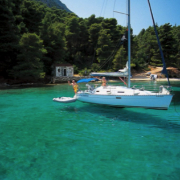 know as he turned up in khaki shorts on that February evening, in Chipping Norton. The chill didn’t seem to have dampened his enthusiasm, though, which bubbled on through his talk. His wife Heidi and the other members of the team of seven he’d brought along were not in shorts.
know as he turned up in khaki shorts on that February evening, in Chipping Norton. The chill didn’t seem to have dampened his enthusiasm, though, which bubbled on through his talk. His wife Heidi and the other members of the team of seven he’d brought along were not in shorts.
Barrie aka 'Mr Flotilla' has several books to his name as well as many articles aimed at improving sailing skills. He received the New Zealand Society Lifetime Achievement Award 2014 for his outstanding contribution to the New Zealand Community in the United Kingdom. He is founder and owner of Sailing Holidays Ltd, the largest British owned and operated flotilla sailing holiday company. It has been in operation, one way or another, for some 40 years. Barrie joined precursor Flotilla Sailing Club in 1979 as an engineer and skipper, and met holidaymaker Heidi Seville In 1983. They ended up married and taking over the company, growing it from 11 Jaguar 27s (I remember those!) to the 178 yachts of the current fleet.
Barrie reminded us how things have changed over the years and waved a clunky RDF (radio direction finder) at us. Those of us in the audience old enough to have used these things had nothing positive to say about them. Barrie stressed how they strive to set things up to make things easy - all the boats, for example, have in-mast mainsail reefing. Positing that the marine diesel is the greatest contributor to marine safety of the last 100 years Barrie ensures that they keep a complete spare engine of every type fitted to the fleet and can do a change “in an hour”.
Clearly Barrie has had enough dealings with officialdom and regulations, which abound in the Med., to finesse his way through them - whether they be rules around over-size life rafts, the need for hatches of questionable value, GMDSS, or location of extra batteries.
Holidays are what Barrie told us they are about - the enjoyment of which he believes hinge not only on ease of boat handling, but also on big (and many) heads, and big beds. Many of their customers move on from flotillas and return to do their RYA courses or venture into bareboat charter - for which they are agents for over 1000 boats. Barrie claimed they’d introduced a mind-boggling million people to sailing.
One of Sailing Holiday’s early customers and friends was Tony Stuart. He and his wife Gill were founder members of Chipping Norton Yacht Club. Tony, a frequent attender of Yacht Club events, had died only a few weeks beforehand, on the 7th February, after a long illness. At the start of the evening Commodore Duncan Wheatley made the sad announcement and passed our condolences to Gill, who was in the audience. Barrie had started his talk showing us a few photos of Tony and Gill in happier times, and in sunnier climes. To round the evening off Sailing Holidays then proceeded to auction a flotilla holiday for 2, with a value of £1000, in aid of two charities that had supported Tony: Shipston Home Nursing, and the Motor Neurone Disease Association. Bidding was lively and the winner, Ralph Wilkin, had an extremely expensive evening.
March 2016
Peter Cardy
Scraping the Bottom - and the Top
In March we welcomed Peter Cardy, a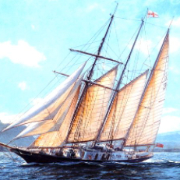 man born with salt water in his veins. Peter has been CEO of many organisations - including Macmillan and the Multiple Sclerosis Society - and was onetime Chief Executive of the Maritime and Coastguard Agency (responsible for maritime law, search and rescue, safety and environmental protection). Always fascinated by the sea, he crewed Tall Ship races as a Sea Scout, worked as a ferryman on the Isle of Wight ferries (a childhood ambition), and told us of the exhilaration and trepidation of skylarking to the top of the Sir Winston Churchill’s topmast. In “retirement” he organised these races.
man born with salt water in his veins. Peter has been CEO of many organisations - including Macmillan and the Multiple Sclerosis Society - and was onetime Chief Executive of the Maritime and Coastguard Agency (responsible for maritime law, search and rescue, safety and environmental protection). Always fascinated by the sea, he crewed Tall Ship races as a Sea Scout, worked as a ferryman on the Isle of Wight ferries (a childhood ambition), and told us of the exhilaration and trepidation of skylarking to the top of the Sir Winston Churchill’s topmast. In “retirement” he organised these races.
Peter spent twenty years running charities concerned with awful diseases: motor neurone disease, multiple sclerosis, cancer. He became closely involved with providing sailing experiences for people with multiple sclerosis, including competing in the Fastnet one year. As he explained, you learn a lot about people on long night watches, and for many sailing was a life-changing experience which restored their self-belief, against the backdrop of a disease which robs many individuals of so much - jobs, hopes, abilities, faculties. As a watchleader ("oh, thirty or forty times") Peter certainly had many opportunities to get to know crew members, able and disabled, old and young, and hear their stories.
As CEO of the Maritime and Coastguard Agency Peter discovered it to be a job of extraordinary breadth and seniority, with many official responsibilities at home and abroad.
Peter was informative and forthright in his views on the organisations he’s led, and challenged and parried our prejudices about the coastguard service and the recent changes to its organisation. The talk was rich in anecdotes of sea experiences, including the dynamiting of a whale carcass (reminiscent of the well-known "Italian Job" quote: “you were only supposed to blow the bloody doors off”!).
Having met the man we began to understand how he managed to head up complex and challenged organisations so effectively, through traumatic times. In his words: “since this is the only world of which we can be certain, we should work to leave it a better place than we found it”.
April 2016
David and Helen Oakley
To Brazil and back
What a great evening with the talk given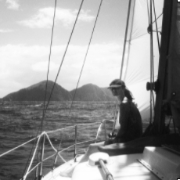 by members David and Helen Oakley, reminding us of what lies at the core of Chipping Norton Yacht Club’s raison d’etre. It has of course been fascinating to hear from yachting greats like Sir Chay Blyth or Mike Golding, but they inhabit a different world from most of us. David and Helen are of our world, live here in Chipping Norton -and have a boat on a trailer in their front drive. In 1997 they ventured across the Atlantic in a family cruising yacht, a Kingfisher 30, taking an unusual route direct to Brazil rather than to the Caribbean, because “everybody does that”. They gave every impression of having had the time of their lives.
by members David and Helen Oakley, reminding us of what lies at the core of Chipping Norton Yacht Club’s raison d’etre. It has of course been fascinating to hear from yachting greats like Sir Chay Blyth or Mike Golding, but they inhabit a different world from most of us. David and Helen are of our world, live here in Chipping Norton -and have a boat on a trailer in their front drive. In 1997 they ventured across the Atlantic in a family cruising yacht, a Kingfisher 30, taking an unusual route direct to Brazil rather than to the Caribbean, because “everybody does that”. They gave every impression of having had the time of their lives.
David started off with a nautical song, accompanying himself confidently on the guitar. The song “had nothing to do with the trip” but set the tone for the evening. David was introduced to sailing young - his father had a 24 ft Tucker in which he’d explored the South Coast, Normandy and Brittany…
OK, the trip. Chichester, Dartmouth, the Yealm. Out to the open sea. The gale (I’ll tell this bit, says Helen - David would downplay it and it was actually pretty terrifying). Two days and two nights of things flying about the cabin and not being sure which way was up. They played cards on the second night, and survived to the euphoria of an open ocean view of the Milky Way, in the glory of no light pollution. Calms, turtles and a whale later they reached Porto Santo (the most northerly and most easterly island of the Madeira Archipelago), thence to Tenerife. They crossed paths with the junk-rigged “Badger” and met the Hills (Annie Hill wrote the famed “Voyaging on a Small Income”), and learnt something of the Hill’s technique for voyaging on a small income, namely to accept invitations to dinner, eat and drink their fill, and then leave.
The passage to Fortaleza, Brazil, took 21 days. They spent a month relaxing and hiking. Then they headed north up to the Caribbean. Chaguaramas Bay (Trinidad), Tobago (“wonderful place”), Grenada, Carriacou, Tobago Cays, Bequia, Guadeloupe, Antigua, Sint Maarten…. ah, the deep blue seas, the pale sands, the leaning palms, the shrieking parakeets and all that sunshine. And more sunshine.
Their trip had been budgeted at a year, as that was affordable. To make it longer, tempting though that would be, would have involved finding work and that’s a whole other game. So a year it was.
So back. Sint Maarten to the Azores took 33 days. A rhythm of watches, with support from magazines, books and tapes (including Alan Bennett’s Talking Heads), was established. The final approach to the Azores involved 300 miles of motoring, and after 33 days at sea, the approaching harbour held fears as well as hope. The final leg, Azores to Ireland, took another 14 days,
David finished with a song, a saga. Written once home. This one was about the trip.
David and Helen shared the speaking, giving each other the cues and asides that married couples can. It worked.
Asked, as they were, about what they’d do differently, it was clear that for them the important thing was to do it, and together, rather than agonise over detail. Yes they’d allow more than a year if they could afford it; yes they’d choose a long-keel boat. But with a year and a modest boat they had their enviable adventure.
May 2016
Phil Levermore
The Determined Sailor of Other People's Boats
CNYC members are a varied lot. Some keep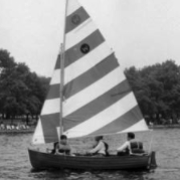 boats in home waters; others, despairing of finding that elusive British summer, prefer sailing in warmer climes. Many, though, prefer not to have a boat at all but get their sailing fix in other people's boats. As a dedicated Sailor of Other People's Boats (SOPB), Vice Commodore Phil Levermore recounted tall tales from his 25 years in borrowed boats. Having sunk a dinghy on the Serpentine aged 11, the only way was up. Racing in borrowed dinghies taught Phil how to bend yacht racing rules, whilst a week on the Sail Training Association's tall ship, 'Malcolm Miller' give him an introduction to girls, beer, and navigation. Having explained how he convinced the RAF, to teach him how to sail yachts properly, Phil then described how a pub lock-in on Alderney lead to a rough Channel crossing and some important lessons being learned. Recounting the delights of chartering in the seas between Corsica and Sardinia, Phil concluded with his pean to UK yachting: 'The UK Theme'.
boats in home waters; others, despairing of finding that elusive British summer, prefer sailing in warmer climes. Many, though, prefer not to have a boat at all but get their sailing fix in other people's boats. As a dedicated Sailor of Other People's Boats (SOPB), Vice Commodore Phil Levermore recounted tall tales from his 25 years in borrowed boats. Having sunk a dinghy on the Serpentine aged 11, the only way was up. Racing in borrowed dinghies taught Phil how to bend yacht racing rules, whilst a week on the Sail Training Association's tall ship, 'Malcolm Miller' give him an introduction to girls, beer, and navigation. Having explained how he convinced the RAF, to teach him how to sail yachts properly, Phil then described how a pub lock-in on Alderney lead to a rough Channel crossing and some important lessons being learned. Recounting the delights of chartering in the seas between Corsica and Sardinia, Phil concluded with his pean to UK yachting: 'The UK Theme'.
Summer 2016
What some members have been up to...
As this is the time of year when many of us get out onto the water, in summer we have informal get-togethers in local pubs, often the Chequers but once this year in The Boat at Thrupp.
get out onto the water, in summer we have informal get-togethers in local pubs, often the Chequers but once this year in The Boat at Thrupp.
So what do members get up to in summer? Many escape to the Mediterranean sunshine; one or two go north to Scotland or west to Ireland; one of us bought a wooden boat in Denmark, and sailed it back to the East Coast; one couple took part in a rally of trailerable boats around the Frisian Islands; one fought gales in the Western Channel coming back from Brittany, one trailed a little gaffer from Chippy marina (his garage) for first sea trials in the Netherlands, and yes, she does float even if the leeway is a bit alarming...
Eleni (that wooden boat bought in Denmark) is a beautifully constructed oak-framed home-built replica of a Greek sponge fishing boat. Low freeboard. Massive sheer. Massive (technically 9.5 tons but probably more). Long keel. The Perkins diesel first served in a combine harvester. Pictured here in Faabourg Fjord she is now snug in her Maldon mud berth.
September 2016
Duncan Wells
Stress Free Sailing
 In September we welcomed Duncan Wells, author, RYA instructor, founder of Westview Sailing, and voice-over expert; voice-over being Duncan’s “proper job”. The instructor in him challenged us on signals with a couple of pictures: a motor-sailing triangle (which was upside down) and a tow cone. We in Chipping Norton Yacht Club can’t be caught out that easily, Duncan!
In September we welcomed Duncan Wells, author, RYA instructor, founder of Westview Sailing, and voice-over expert; voice-over being Duncan’s “proper job”. The instructor in him challenged us on signals with a couple of pictures: a motor-sailing triangle (which was upside down) and a tow cone. We in Chipping Norton Yacht Club can’t be caught out that easily, Duncan!
Duncan is best known for his book “Stress Free Sailing” and that was his theme. A sister publication “Stress Free Motorboating” is imminent. As he reminded us, it is all too easy to frighten the family - one shouty incident can put them off to such an extent that they never come again, so de-stressing pays dividends.
A lot of grief arises around getting off pontoons or, worse, coming onto them, and Duncan explained his techniques. He showed us videos of how he uses springs and bridles, how he lassoes a cleat, or motors against a spring. Made it all look very easy.
Duncan came equipped with bits of rope and a lifejacket, which he wore for some of the evening (the lifejacket). With the rope he showed a few of his favourite knots; the audience particularly liked the “rustler’s hitch” which he demonstrated with volunteers to hold up a boat hook as a surrogate horse-tethering bar outside a wild west bank. No one was asked to be the horse. (The rustler’s hitch can be undone in a trice with a tug on it’s bitter end, so, as a bank robber, one can be out of there and out of rifle range in a jiffy.)
Duncan also brought along a patented life-saving kit that he markets - the MOB Lifesaver. Simple but ingenious, it is a short length of thin but very strong floating line, terminating in a loop, that is kept attached to the inside of the lifejacket. When the lifejacket is deployed, the line floats free and is easily retrieved by the saviour, with the casualty attached. Fishing people out of the water is much more difficult than most realise and this device makes it easier, quicker and more certain.
All good stuff and although much of Duncan’s material was familiar to many of us it was good to be reminded of good practice. Duncan is a good presenter, with nice anecdotes and an amusing turn of phrase that kept us entertained.
October 2016
Dick Durham
Confessions of a Cruising Correspondent
 Dick Durham served on the last working Thames barge before writing for national newspapers and sailing magazines. He joined Yachting Monthly in 1998 as Feature Writer and News Editor and has travelled the globe in search of sailing stories. Still a big part of the magazine, his role is now Editor at Large.
Dick Durham served on the last working Thames barge before writing for national newspapers and sailing magazines. He joined Yachting Monthly in 1998 as Feature Writer and News Editor and has travelled the globe in search of sailing stories. Still a big part of the magazine, his role is now Editor at Large.
Dick opened by telling us that the East Coast was the “third world of yachting “ and proceeded to entertain us with recollections, history and anecdotes covering boats he’s sailed or owned, foul-ups he and others have made, and the skippers and crew he’s sailed with. He did the voices, and had many of us laughing out loud (a rare event at the Chipping Norton Yacht Club). The coast, from the Humber to Dover, has 13 rivers, 60 creeks, a multitude of swatchways, and a vast number of wrecks to testify to the challenges some skippers had failed to rise to. There are hundreds on The Goodwins alone.
We who sail more-or-less modern boats forget that for a long time sailing boats had no engines. If wind failed and the anchor work was not brisk the tide would take you where it would. Perhaps into the side of an anchored naval vessel being painted at the time, a job not improved by an applique of hay, stuck to the wet paint.
Dick told us of the Deal boatmen who had fistfights on the beach over salvage disputes, of a brandy barrel that was found to be surprisingly heavy after all the brandy was drunk (owing to the dead monkey). He told us of Black Tail Spit (the East Coast Cape Horn), and of a horseman rescued from his swimming horse, which had to be tied alongside as no one could work out how to get it aboard. He showed us pictures of some of the wrecks, beacons, derelict Mulberry harbour components, towers and other strange structures that punctuate these swirling waters.
Most memorable was the reading from the Seagull owner’s manual that had many of us laughing rather hysterically. This very serious, rather pompous, and long-winded bit of prose announced that there were two sorts of Seagull owner - the sort that had no problems and the sort that had them in spades. It was absolutely no fault, it implied, of Seagull or the design or quality of its engines, that you were one of the problem-attracting set. You really should snap out of it.
Over a drink after the talk one of us asked Dick whether he could help us get a few words about our club into Yachting Monthly, and he said he’d be happy to receive something. Unfortunately (or fortunately) in the following week he told us he’d already written it. So keep an eye open for this in YM, around Christmas. We did stress to him he should not assume that Chipping Norton Yacht Club members had anything to do with the notorious Chipping Norton Set. We’ll see.
November 2016
Andrew Pindar
The Business of Boating – The Pindar Journey
Andrew Pindar had arrived hot foot from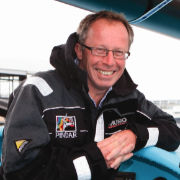 the World Sailing Forum in Valletta, where he’d been engaged in debate about the future of competitive sailing - multihulls v monos, whether design should give racing craft a better chance of subsequent use after laurels are won or lost...
the World Sailing Forum in Valletta, where he’d been engaged in debate about the future of competitive sailing - multihulls v monos, whether design should give racing craft a better chance of subsequent use after laurels are won or lost...
Andrew was born by water in the seaside town of Scarborough, North Yorkshire. A close friend came from a mad keen boating family, and Andrew was “dragged along” on water ski boats and Shearwater catamarans. He thought the water ski boats would be a better magnet for the girls, but in the event spotted his wife-to-be rowing ashore from her dad’s yacht. Sailing with her dad, which seemed a good tactic, may have been fraught at times but led him into marriage and later into sponsorship…
Involvement with sponsorship started small with a North Sea race, from Scarborough to Ijmuiden, and a growing realisation that sponsorship could present superb promotional opportunities for a company of the kind he was then part of (the family business - a world-class printing and publishing business). Through sponsorship he met Chay Blyth, who’d attracted 100,000 onlookers to a race start.
Andrew then proceeded to rattle off the names of practically all the great and good of yachting whom he’d come to know. He spoke of Pete Goss, Ellen McArthur, Alec Rose, Francis Chichester, Clare Frances, Naomi James, Mike Golding, Tracy Edwards, Emma Richards…
He showed us a video of Emma sporting nasty bruises from climbing the mast to sort out a halyard problem in heavy seas during the 2002 round-the-world race, and of her triumphant return in May 2003 with 29,000 miles under her belt to become the first woman and the youngest ever person to circumnavigate.
Andrew is a keen supporter of sailing for the disabled. His second video of the night featured Hilary Lister, a quadriplegic sailor who, in her own words says, “When I'm sailing I go into a different world... it's like flying!”. The freedom sailing gives her is indeed extraordinary - and the re-use of old wheel chair parts to control a boat rather satisfying. With Andrew’s help, Hilary has sailed the Channel solo (in a little over 6 hours) and has her sights set now on other, bigger, sailing challenges.
Andrew lamented that we were still using 50-year-old designs (and even 50 year old boats) in the clubs open to youngsters to learn sailing, so it was no wonder that interest was tailing off.
The family business hit the buffers a few years ago, leaving Andrew with more time to pursue other things - and he did, establishing GAC Pindar with GAC (Gulf Agency Co.) to act as ship’s agents and handle the ever more complex logistics of ocean racing and extreme sailing. This seems go from strength to strength, with Team Australia and the Americas Cup amongst the customers.
As an encore Andrew told us a rather different story: of “Hatherleigh”, a de-commissioned trawler he’d owned, the fish hold of which he’d converted to a bar. At St Tropez in 2004, he’d run a free bar for the crews, which managed to attract practically all the RIBs in the harbour. In this same trawler he’d staged a rescue that had involved days of cruising to a disabled Volvo 60. “The longest rescue in British maritime history” as he phrased it.
(For the record: Andrew waived a fee for giving us this talk, but asked us to make a donation to Hilary’s Dream Trust, which we have been delighted to do. Good luck Hilary in your next endeavour!)
Christmas 2016
"In the bleak midwinter"
...was half the answer to one of the questions in Barnaby Scott’s taxing Christmas quiz - one of the highlights of Chipping Norton Yacht Club’s December gathering. The question was posed with a short piece of printed musical score. Easy enough if you can read music. Not if you can’t. The other half of the question? Who wrote it?
For another question he’d prepared sets of 10 timber samples, the wood of which we had to identify. Bits of doggerel were there to help. I asked him afterwards how easy this was for him, as a professional woodworker, and whether he could do it by touch and feel. “Nah!” he said, “I don’t need to touch or feel - the smell is quite enough”...
A photo competition (stitched together into a movie by Hugh Woodsend) ran on the big screen, showing something of where members had been and what they’d seen during 2016 . We saw rusting hulks, sunsets, picturesque lighthouses, speeding hovercraft, beautiful anchorages, fine wakes behind far-sighted helms(wo)men, narrowboats and gaffers. Chris Adams won with an evocative shot (below) of The Strand - the drying channel between Colonsay and Oronsay in the Inner Hebrides.
into a movie by Hugh Woodsend) ran on the big screen, showing something of where members had been and what they’d seen during 2016 . We saw rusting hulks, sunsets, picturesque lighthouses, speeding hovercraft, beautiful anchorages, fine wakes behind far-sighted helms(wo)men, narrowboats and gaffers. Chris Adams won with an evocative shot (below) of The Strand - the drying channel between Colonsay and Oronsay in the Inner Hebrides.
Hugh had also put together another movie with highlights of this season’s talks; from members about their sailing exploits, from sailing or maritime professionals, from authors who write about sailing. This is now available for download at: https://secure.sharefile.com/Authentication/Login. The login name is: cnyc@btinternet.com and the password: Sailing2016 - this is case sensitive. Unless you have incredibly fast internet and no data cap, you should download the 'small' 842MB file.
But all this was background to an informal gathering, with Christmas as our excuse, at which we could chat to fellow enthusiasts about the things we get up to, or plan to get up to, on or around the water.